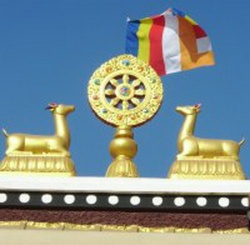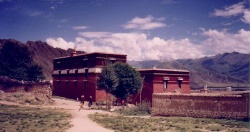The Gelugpa Monastic Curriculum
By Miranda Adams
The curriculum of the Gelug Monasteries focuses on the explication, debate, and understanding of the philosophy of the Indian Buddhist scholars, as interpreted by Tsongkhapa. To graduate with the highest degree of Geshe Lharampa, the Monk studies five subject areas based on five essential Indian texts over a period of approximately 20 years. These are:
Pramana (tsad ma) – the study of logic and reason, based on Dharmakirti’s Commentary on Valid Cognition (Skt: Pramanavartika, Tib: tsad ma rnam ’grel).
Prajnaparamita (phar phyin) - the study of the grounds and paths of the Mental continuum as it progresses toward Enlightenment, based on Maitreya’s Ornament of Realization (Skt: Abhisamayalamkara, Tib: mngon rtogs rgyan).
Madhyamaka (dbu ma) – the study of the view of Emptiness according to the philosophical system of the Middle Way, based on Chandrakirti’s A Supplement to Treatise on the Middle Way (Skt: Madhyamakavatara, Tib: dbu ma La ‘jug pa).
Vinaya (’dul ba) – rules of Discipline for monastics, based on Gunaprabha’s The Vinaya Sutra, (Skt: Vinayasutra, Tib: ’dul ba’i mdo).
Abhidharma (mdzod) – special topics, including cosmology and so forth, based on Vasubhandu’s Treasury of Knowledge (Skt: Abhidharmakosha, Tib: mgon par chos kyi mdzod)
This curriculum is supplemented by occasional commentaries and teachings on complementary subject matter, and by regular teachings on Lamrim, the practical application of the stages of the Path to Enlightenment.
The method of study in the Monasteries is a combination of logical analysis and debate (mtshan nyid), combined with regular sessions of Prayer and recitation, which is considered an essential condition to ripen the positive results of Intellectual pursuits.
Although the root of the philosophical systems that are studied, practiced, and debated in the Gelug monastic institutions stem from the teachings of Je Tsongkhapa Losang Drakpa and his main disciples Gyaltsab and Khedrupje, but many of the actual textbooks that are used as a basis of study in the Monasteries are themselves commentaries on these works. These commentaries take the Form of compositions called yigcha (yig cha), which take a unique Form modeled around the Tibetan debate format.
Each of the three great Monasteries, and some of the schools within them, follow yigcha written by different authors, who agree on the major points of the philosophy but debate extensively on the interpretation of the finer points.
Ganden Jangtsey and Sera Je follow the yigcha written by Jetsunpa Chokyi Gyalsten. Sera Me uses textbooks written by Jetsunpa’s Disciple Kedrub Tendarwa. Ganden Shartse and Drepung Loseling Monasteries follow the texts written by Panchen Sonam Drakpa. Finally, Drepung Gomang and Drepung Deyang Monasteries follow the texts written by Kunkyen Jamyang Shepa Ngawang Tsondru. Labrang Monastery also follows Jamyang Shepa’s yigcha.
Upon successful completion of this curriculum, and depending on the level of detail engaged in, the Monk may attain the degree of Geshe (dge shes).
The Geshe degree tradition began during the Time of the 5th Dalai Lama in the 17th century. The tradition underwent a reformation during the Time of the 13th Dalai Lama, who returned from a visit to Mongolia impressed by the scholars there and determined to elevate the academic standards in the educational institutions of Tibet. Prior to this Time, the Geshe degree was not necessarily awarded on the basis of academic Merit. The 13th Dalai Lama also established other reforms in relation to the Geshe degree, including requiring those who graduated with highest honors to proceed to Tantric College to complete their educations.
Today, the Geshe degree is awarded at the completion of the course of study in the monastic institutions. At Ganden, Drepung, and Sera Monasteries, there are four levels of Geshe degree: Lharampa, Tsogrampa, Rigrampa, and Lingse. The highest level Geshe degree is called Geshe Lharampa, and is awarded to the most superior scholars.
Once a Monk has completed the Geshe degree, they may become teachers in the Monasteries, training the next generation of students, or return to their home areas and give teachings and so forth for the local communities. Others choose to continue their educations with further study of the Tantras or the Sutras, or to pursue solitary Retreat based.

